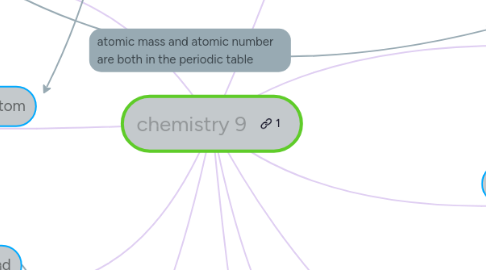chemistry 9
by Priscilla Sung

1. 1-how to calculate protons, neutrons, and electons
1.1. 1-protons- same number as atomic number
1.2. 1-neutrons- atomic mass- atomic number
1.3. 1-electrons-atomic number unless it is charge
2. 9-naming rules for multivalent compounds
2.1. 9-Use roman numerals when naming compounds if the periodic table lists more than one charge. Add -ide to the end of the final element.
3. 2-what is the atomic mass
3.1. 2-the mass of an atom of a chemical element expressed in atomic mass units
4. 4-what does charge do to an atom
4.1. 4-A charge makes it an ion.
5. 5-what is a covalent compound
5.1. 5-A covalent compound is a compound in which the atoms that are bonded share electrons rather than transfer electrons from one to the other
6. 3-what is the atomic number
6.1. 3-the number of protons found in an atom
7. 6-what is an ionic compounds
7.1. 6-ionic compounds are made up of a metal and non-metal
8. 8-naming rules for polyatomic compounds
8.1. 8-the positive ion is written first, followed by the negative ion
9. 7-naming rules for ionic compounds
9.1. There are different types of ionic compounds, but the general rules in naming them are: •Identify and name the cation •Identify and name the anion
10. 10-naming rules for covalent compunds
10.1. 10-covalent compounds are generally named by using prefixes to indicate how many atoms of each element are shown in the formula.


